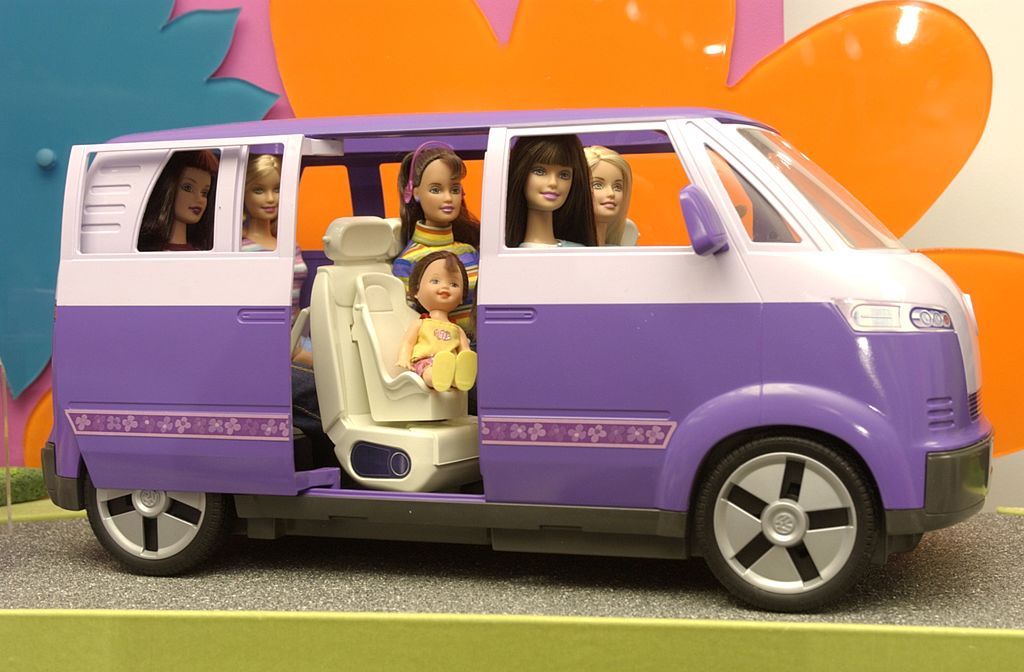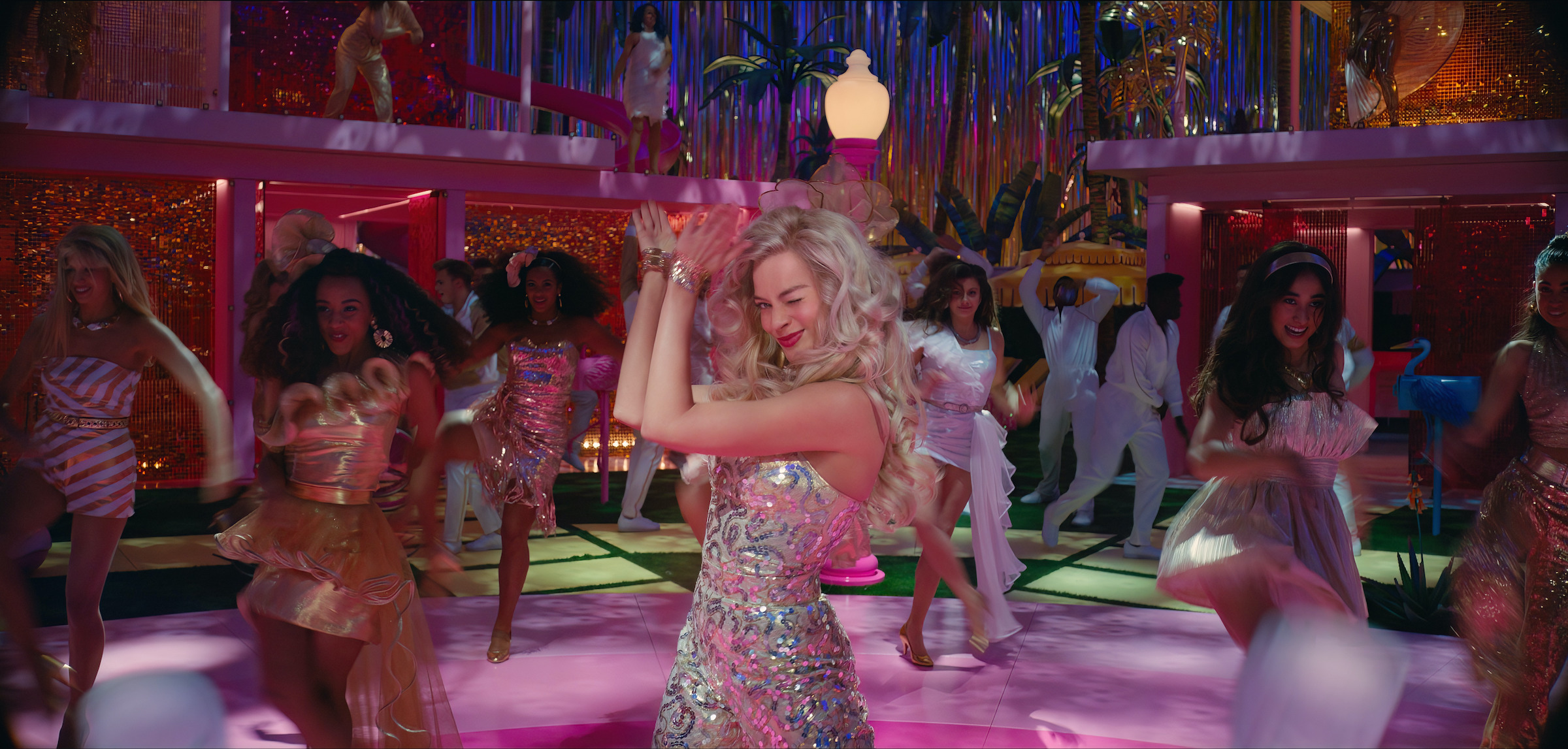
Barbie, that minx, invaded my home against my mom’s inclinations, as she did for so many Generation Xers and millennials. Our Boomer parents’ sensibilities were offended by her frivolous existence. Nonetheless, she wiggled her way in. My family legend has it that our apartment’s pioneering Barbie, outfitted in spandex and leg-warmers, was a gift from a passive aggressive friend of the family, the same one who also “accidentally” got my brother and me boxes with lead paint on them.
Regardless of Workout Barbie’s origin, she was followed soon thereafter by Astronaut Barbie, wearing thigh-high hot pink boots and a shimmery spacesuit, and then a third Barbie of unknown name, in a flowery dress, less tethered to the modern era and more ready to be absorbed into my pretend games of “olden times” and fairy tales. That was the turning point. Those first few dolls were soon joined by dozens of companions, including Barbie’s racially and culturally diverse pals, her little sister dolls, and one Ken. They arrived on birthdays and Hanukkah, gifts from school friends and relatives, and even occasionally from my parents. My collection became a focal point for playdates at my place. The dolls commandeered the drawer under my bed, and spread themselves to all corners of my room during the games my friends and I played with them, practically until we hit puberty.
Read More: How Barbie Came to Life
More from TIME
And yet even as I was sliding those ridiculous high heels on my Barbies’ ankles, I was also plotting the revolution, to the degree a child can. I was a pint-sized feminist, an advocate for reproductive rights, and a self-styled tomboy in homage to my favorite heroines of Y.A. literature. I was not actually a tomboy: I was a bookworm, obsessed with classics of girlhood like Anne of Green Gables and Little Women, and also devouring nonfiction books about mythology, history, and even sports. At the same birthday parties where one friend would bestow me with a lacy pink Barbie outfit, another would buy me a book about “Great American Women” where I learned to admire very un-Barbielike figures such as Sojourner Truth, the Grimke sisters, Rosa Parks and Eleanor Roosevelt.
That seeming contradiction—Barbie-loving feminist—long puzzled me. I’ve been mulling over Barbie’s impact on my psyche, basically since I stopped playing with her, and more recently, as Greta Gerwig’s forthcoming live-action Barbie movie has put the doll at the center of the discourse. In the pages of a feminist ‘zine that friends started at the end of the ’90s, I argued in favor of Barbie, saying that those hours of open-ended imaginary play she fostered helped build me into a creative person, and taught me to value independence, storytelling, and collaboration with friends.

As an adult, and a parent, I think the truth is more complicated. I remember unboxing a Barbie and removing her accessories from their plastic slots with a kind of hungry acquisitive need. I remember the crazed, semi-competitive way my best friend and I would demand the very same Barbies from our parents. Now, when I wake up on Saturdays and scroll Instagram, I still trick myself into believing that a great bargain on outfits for the kids, or me, will fill a week’s worth of emptiness and exhaustion. Barbie culture helped indoctrinate us into the idea that consuming, accessorizing, having the perfect “stuff” would complete us, and thereby line Mattel’s pockets, because we were always left wanting more.
I also remember how horrified I was when, at age 12 or 13, just after I had abandoned Barbie, I discovered that I was no longer growing taller, but instead had sprouted new hips. Suddenly, jeans and skirts didn’t fall straight down on me the way they did on all my Barbies, and I didn’t like this development (so to speak) at all. I was being welcomed into a lifetime of typical, but no less painful, body image angst.
Of course, pernicious messages about consumption and beauty came from many places other than Barbie: television shows, movies, magazines, older people. But our Barbie dolls, roughly dressed, undressed, and reconfigured, had their role too. Criticisms of Barbie’s negative qualities have predominated discussion of her social impact: those silly heels, the pink car, the completely unrealistic body that would tip over in real life, the whiteness and blondeness, the privileging of fashion and beauty over brains. And yet, so many of us played with her—and we’re all going to see the movie anyway, according to the ticket sales ahead of the July 21 release. We will see it, with the gleeful anticipation I used to feel at school when I knew I had a playdate coming up that day, and the Barbie drawer would be raided.
Read More: The Real Reason Barbie Might Dominate the Box Office
Whatever our adulthood looks like today, whether we are gender nonconforming or ultra-feminine or parents or career-oriented or all of the above, anyone who is not a man has to spend their days negotiating with the ever-present forces of consumerism and monolithic beauty culture that Barbie embodies. Nowadays, we can’t just chuck the aspects of society we despise down the laundry chute, as we did with our Barbies.
But maybe we wish we could.
Perhaps that constant negotiation explains why, as generations have (by and large) embraced queerness, feminism, anti-capitalism and, yes, wokeness, they also feel a kind of ownership over this problematic doll franchise. Barbie’s plastic-ness, her financial accessibility, her generic quality, meant we could turn her into whatever we wanted—including an avatar for our most violent, strange and wildly imaginative tendencies. Kids tied up their Barbies, dismembered them, acted out conflicts, and held orgies, too. Ken was an afterthought, a joke (a fact the film seems eager to play with). Whether whole or headless, whether we revered her or destroyed her or both, Barbie was subsumed into our own ideas about how to play. Unlike paper dolls or American Girl dolls that came attached to a historical era, or were too expensive to own or play with, Barbie was a toy as soon as she came out of the box: we could cut her hair, change her outfit, and immediately make her over in whatever image was on our mind, or forget about her entirely. It was a bit rebellious, taking a doll that was supposed to look a certain way and making her behave our way.

Mattel’s other ’80s franchises, including the She-Ra dolls that I loved before I got into Barbie, didn’t have this moldable quality. At my house, Barbie was almost always starring in epic, days-long imaginary games full of love affairs, violence, and betrayals. For others, she was sitting around boardrooms or visiting beauty salons or getting murdered by pirates, or being a murderer herself. Barbie provided an easy way for kids, mostly girls, alone and in groups, to control their own narratives, make up their own stories, and indulge in their own fixations. And in that way, she made the idea of adulthood, and womanhood, something younger girls could try on and experiment with, or simply fire down the hallway like a blonde torpedo. I don’t want to get too in the psychological weeds about the cultural ubiquity of girls torturing their woman-shaped dolls, or making these comically busty avatars of womanhood hump each other, but it sure is interesting, isn’t it? And perhaps worth unpacking over drinks, after we see the movie together.
Out now: TIME’s new special edition about Barbie is available at newsstands and here online
Many wonderful films about girlhood make boys and puberty the focal point, or dwell on girls’ relationship with their mothers. But for so many of us, playing with Barbies was about our relationships with ourselves and our friends, and all the ways those experiences blended with the broader culture of materialism and femininity. That’s why a smart, feminist director like Gerwig offering her take on Barbie—and doing it in a way that appears to foreground ambivalence, humor and neon—feels so exciting.
It’s not like we expect Gerwig to offer a full-throated critique of Barbie—the movie, after all, is produced by Mattel. But what matters is how the film appears to recognize Barbie’s simple presence in so many of our young lives. It means millions of girls’ intense, silly, and personal childhood play is being acknowledged, given the royal Hollywood treatment, and taken both as seriously and unseriously as we took our Barbies themselves.
Seltzer is the author of the novel The Singer Sisters (Flatiron, 2024) and an editor at Lilith Magazine
More Must-Reads from TIME
- Caitlin Clark Is TIME's 2024 Athlete of the Year
- Where Trump 2.0 Will Differ From 1.0
- Is Intermittent Fasting Good or Bad for You?
- The 100 Must-Read Books of 2024
- Column: If Optimism Feels Ridiculous Now, Try Hope
- The Future of Climate Action Is Trade Policy
- FX’s Say Nothing Is the Must-Watch Political Thriller of 2024
- Merle Bombardieri Is Helping People Make the Baby Decision
Contact us at letters@time.com